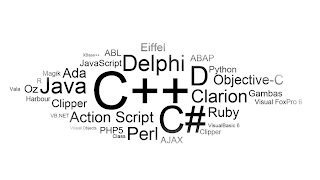In programming languages an object is the composition of nouns (like data such as numbers, strings, or variables) and verbs (like actions, such as functions).
An object-oriented program may be viewed as a collection of interacting objects, as opposed to the conventional model, in which a program is seen as a list of tasks (subroutines) to perform. In OOP, each object is capable of receiving messages, processing data, and sending messages to other objects. Each object can be viewed as an independent "machine" with a distinct role or responsibility. Actions (or "methods") on these objects are closely associated with the object. For example, OOP data structures tend to "carry their own operators around with them" (or at least "inherit" them from a similar object or class)—except when they must be serialized.
Simple, non-OOP programs may be one "long" list of commands. More complex programs often group smaller sections of these statements into functions or subroutines—each of which might perform a particular task. With designs of this sort, it is common for some of the program's data to be 'global', i.e., accessible from any part of the program. As programs grow in size, allowing any function to modify any piece of data means that bugs can have wide-reaching effects.
In contrast, the object-oriented approach encourages the programmer to place data where it is not directly accessible by the rest of the program. Instead, the data is accessed by calling specially written functions, commonly called methods, which are bundled in with the data. These act as the intermediaries for retrieving or modifying the data they control. The programming construct that combines data with a set of methods for accessing and managing those data is called an object. The practice of using subroutines to examine or modify certain kinds of data was also used in non-OOP modular programming, well before the widespread use of object-oriented programming. Download Here
-->









0 comments:
Post a Comment